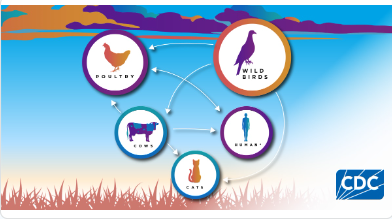#18,622
Late yesterday afternoon the state of Arizona announced their first detection of HPAI H5N1 in dairy cattle - and like with Nevada 10 days ago - it has been identified as genotype D1.1. Prior to these two recent events, all of the 960+ dairy herd infections have stemmed from genotype B3.13.
While some research has suggested that other genotypes might spillover into cattle (see Germany: FLI Statement On Experimental Infection Of Dairy Cows With European H5N1 Virus), the USDA and the dairy industry has banked on the notion that this was not an ongoing spillover event, making it `easier to contain'.The assumption by the USDA has long been that B3.13 entered dairy cattle via a single spillover from birds - roughly a year ago in Texas - and was then spread to other states by the interstate transport of infected cattle.
Genotype D1.1 arrived to the Pacific Northwest last fall via migratory birds, and has sparked a huge uptick in poultry farm outbreaks across the nation, including nearly 20 human infections; three of which have now produced serious illness (1 fatality).
The discovery 10 days ago that D1.1 had been detected in a herd in Nevada has quashed the idea that the B3.13 spillover in Texas was somehow a unique, one-off, event. Yesterday's announcement that D1.1 has been found in another herd 500 miles away, only reinforces that concern.
Late yesterday APHIS published the following statement on the Arizona report, which also confirms that this was a `third spillover' and that it `. . . may indicate an increased risk of HPAI introduction into dairies through wild bird exposure.'
First the press release, after which I'll have a postscript.
APHIS Identifies Third HPAI Spillover in Dairy Cattle
On February 13, 2025, the USDA Animal and Plant Health Inspection Service (APHIS) National Veterinary Services Laboratories (NVSL) confirmed by whole genome sequence a detection of highly pathogenic avian influenza (HPAI) H5N1 clade 2.3.4.4b, genotype D1.1 in dairy cattle in Arizona. This confirmation was a result of State tracing and investigation, following an initial detection on silo testing under the USDA’s National Milk Testing Strategy (NMTS).
USDA APHIS continues to work with the Arizona Department of Agriculture by conducting additional on-farm investigation, testing, and gathering additional epidemiological information to better understand this detection and limit further disease spread.
The detection of this virus genotype in dairy cattle is not unexpected, because genotype D1.1 represents the predominant genotype in the North American flyways this past fall and winter and has been identified in wild birds, mammals, and spillovers into domestic poultry. Whole genome sequencing indicates that this detection is a separate wild-bird introduction of HPAI to dairy cattle, now the third identified spillover event into dairy cattle.This finding may indicate an increased risk of HPAI introduction into dairies through wild bird exposure. Biosecurity is still key to mitigate the risk of disease introduction or spread between premises; APHIS recommends enhanced biosecurity measures for all dairy farms. Producers should immediately report any livestock with clinical signs, or any unusual sick or dead wildlife, to their state veterinarian.
The detection does not change USDA’s HPAI eradication strategy and is a testament to the strength of our National Milk Testing Strategy (NTMS). In the interest of sharing information of import to the scientific community, APHIS will publish a technical brief on the findings on our website and post the sequence data on GenBank in the coming week.
Bland assurances aside, we are nearly a year into this crisis and we still don't have comprehensive, nationwide testing for HPAI in dairy cattle. While the Nevada and Arizona herds were detected by the NTMS, the status of many other herds across the nation remain unknown.
Additionally, very little testing is being done outside of dairy herds, despite sporadic detections in goats, in alpacas, and even swine. Our `Don't Test, don't tell' mindset remains a major barrier to getting a handle on the true scope of the problem.
Outbreaks in cattle, poultry, and wild birds have led to numerous knock-on infections in humans, and in myriad peridomestic and farm animals (e.g. cats, mice, voles, pigs, poultry, etc.). Serological testing suggests the number of human infections may be much higher than official numbers would suggest.
While we've stared into the H5N1 abyss before, only to see it recede, this time `feels' different.
The virus now infects a much wider range of avian and mammalian hosts, has spread to 9/10ths of the world, and it continues to diversify into scores of new genotypes. There is very little reason to believe this forward progress will stop anytime soon.
Yet the decision has been made to dramatically cut back on the CDC's, and other agency's, ability to deal with this looming crisis.
Stay tuned, and fasten your seat belts. It could be a bumpy ride.
